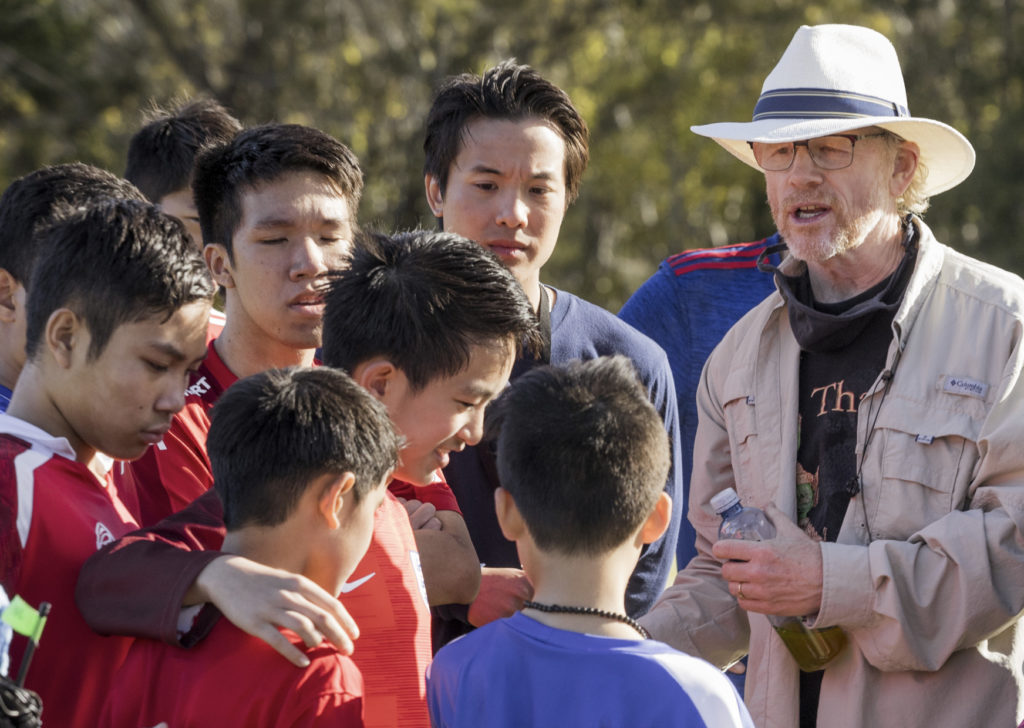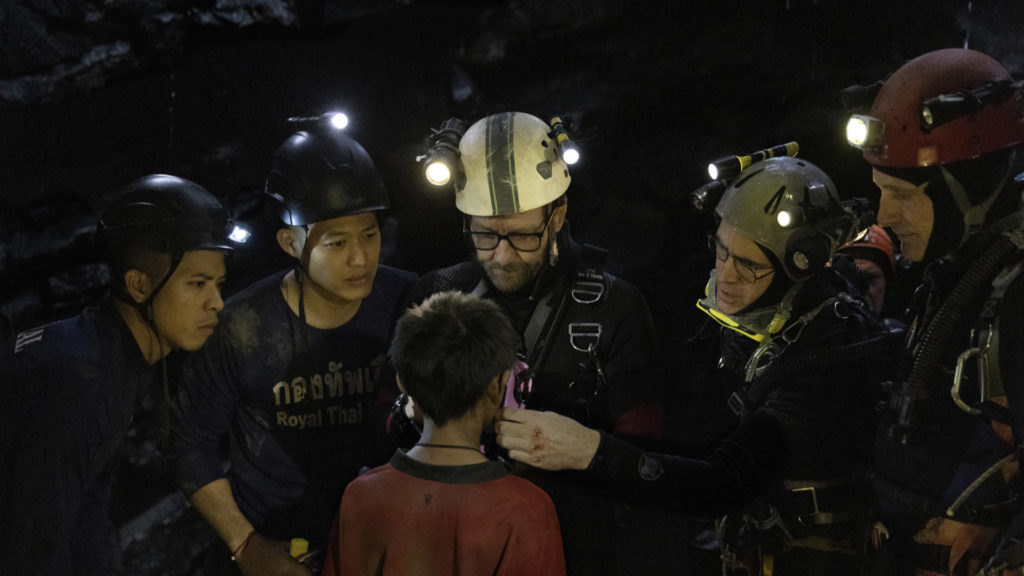Q : Allow me to welcome to the stage, the producer and director of Thirteen Lives, Ron Howard.
Hello, Ron.
RON: Hi, Jacqueline. How are you?
Q : Excellent. Well, first of all, thank you so much for joining us this morning, and for putting on this event to talk about this incredible film. I first want to start with you sort of signing on to this because it is another example of this global event that so many folks know about, but we want to see in this narrative format to really take it and make it a global event. So what made you want to tell this story?
RON: Well, like a lot of people, all those people that you’re talking about, you know, I was aware of what was going on. My wife Cheryl was really glued and paying attention, and, of course, the outcome was a relief to the world. And it was, you know, it was one of those tremendous moments. When I had a chance to read William Nicholson’s script, though, it not only delivered on everything that I had recalled, but it just suggested so much more.
There were just more levels and dimensions to the heroics, to the people involved, especially the Thai people. And there were surprises in this story that I, you know, I just felt like I could make something, you know, really visceral and immediate, and do what a, you know, a scripted version of a telling of a true story’s supposed to do, which is, you know, make it more engaging.
And sort of, you know, sort of engage the nervous system of the audience in addition to trying to give all the information. So it was a really exciting creative opportunity for me, and I knew I would learn a lot, too, about, you know, Thai culture and a number of other things.
Q : What’s so interesting about this is, as I was getting ready for this event, of course, I want to revisit the filmography, and revisit some of the things of the folks that I’m speaking of. And when I was looking it over, just the idea of your filmography, at this point in your career, to say you’re going to do something new, I think, a lot of folks can look and see similar things that you’ve done like this. But this was really something completely different ‘cause it’s not just the rescue that everyone knows. It really does talk about this emotional journey of human connection, and what we were all sort of, I think, grasping for when everyone was glued to their screens, trying to find out. So, yeah, talk about, again, how you were able to, I guess, explore all of those themes within this one.
RON: Well, I have had a lot of experience working on stories based on real events, and I’ve now also, you know, begun making documentaries, as well. And I knew that there was a documentary being made of this film. In fact it’s with one of the same producers, P.J. van Sandwijk, is a producer on both. But I also knew that by getting really granular and personal, and emotional, that this could be a very extreme version of, you know, my favorite kinds of films that, you know, the kinds of films that prove that remarkable outcomes, you know, are not the stuff of fiction.
That when people pull tighter, incredible things can happen. And this is just a tremendous case study. But as a director, I also knew it was gonna be an exciting challenge. That drama in the cave, I knew that was gonna be a cinematic challenge that I was excited to meet. I knew that the acting opportunities were gonna be, you know, very emotional and focused. And I also knew that, you know, a large percentage of this story was gonna be in Thai.
And it needed to reflect Thai culture and these characters in, you know, in very nuanced, very connected, contemporary, thoughtful ways. And I knew that there was a lot of entertainment value and power in that, if we could get that right.

Q : Excellent. Thank you. But I wanted to, right before we bring out the rest of our panelists, talk about that because, yes, you know, folks, obviously, true-life events this is not your first rodeo in that avenue. But with this one, in particular, I find that whatever pitfalls, or what I would say upsides there are to telling a familiar story, were exacerbated by this, and it is a balancing act with things that you obviously get, which is the familiarity, but then there’s a whole host of other things when you’re talking about real-life people that the world remembers. So how did you sort of balance that through both the pre and post-production to sort of keep both of those things true and authentic?
RON: Well, this is where a lot of my experience really did come in handy because I’ve learned to trust the collaborative process in all of this. So I’m not only doing my own research, seeing everything that I can see, reading what I can read, but, you know, I was also, you know, able to engage with Rick Stanton, John Volanthen, and Jason Mallinson, Chris Jewell. The divers who actually, you know, executed the rescue. But also, I was able to deputize not only a couple of co-producers who could come in who were producer/writers and a writer/director.
You’ll meet them a little bit later. And, also the cast. And look, this story is very, very important to Thai culture. And understandably so. And something, a story they should be incredibly proud of because of the way the Thai government and Thai leadership actually made this rescue possible. And the more I learned about it on a very emotional level, I realized that there was, yes, the epicenter of this were the caves and the boys and the coach and the intensity and focus of that rescue. Very cinematic and intense and suspenseful.
And I wanted to capture that. But there was incredible involvement in other places. People taking real risks, physical risks, emotional risks as the stakes kept getting higher and higher up on the mountain, trying to divert the water, trying to keep the system going. The parents doing everything that they possibly could on an emotional level, on a spiritual level, everything that they could think about. And the more I learned about the story, the more I, sort of as said earlier, the more dimensional I felt it could be, the more entertaining it could be.
And I also kept going back to the real virtues and strengths of William Nicholson’s. That initial draft, which did such a great job of distilling this story into something that was a movie. It’s suspenseful. It had, you know, it had all the things that you’re looking for in a great movie story. And, yet, we could tell it with honesty and integrity, and that was our goal. And everybody on the production felt this and shared it. And it was one of those really joyous situations where we just knew, you know, you didn’t have to ask for an extreme effort from people. They were giving it. By the way, they were volunteering for it. This is such a story of volunteerism, and that does distinguish it in some ways from other kinds of rescue films where people are doing what they’re trained to do. In this case…
Q : What they’re paid to do. Yeah. Exactly.
RON: Paid to. And here you’ve got this tremendous, tremendous impact of volunteers who do not have to be there. And yet they are, and they’re making a huge difference in the cave, on the mountain, at the campsite. I love that so much, but hey, don’t take my word for it, although, I’ve had the pleasure of enjoying every minute that you spoke of. And everything that you are alluding to, plays out incredibly through the runtime of this film. But why don’t you go ahead and set up this clip and have folks sort of take a look for themselves. Okay. Well, this is…
Q : This is the last one. Yeah, this is that moment. Yes.
RON: So it’s important to understand that while volunteer divers, who are expert cavers, and, you know, did tremendous work extricating the boys and the coach, that the Thai Navy SEALs who had begun the effort before the volunteers could get there, but they also embedded with the boys to help them survive, navigate. One of them was a doctor. And, of course, as the rescue went through this gauntlet of these three intense days, they were, of course, there. They’d been there many more days prior to that.
But they insisted that they had to be the last ones out. They needed every child, they needed every volunteer to be out before they would go. And that was their commitment. And with the monsoon rains coming, and the flooding intensifying, their journey out was the most precarious of all. So we’ve picked this up at the moment when we recognize that the divers are out, the boys are out, but, you know, it’s still uncertain as to whether the SEALs are gonna be able to make it safely back.


